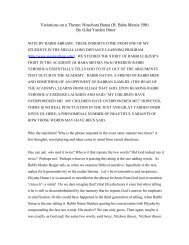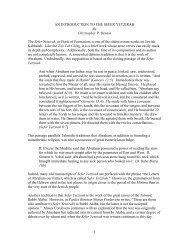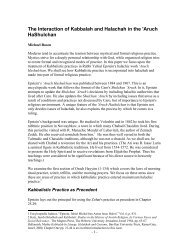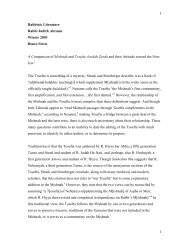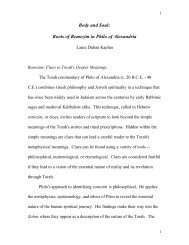The Symbolic Representation of the Sefer Torah - Maqom
The Symbolic Representation of the Sefer Torah - Maqom
The Symbolic Representation of the Sefer Torah - Maqom
You also want an ePaper? Increase the reach of your titles
YUMPU automatically turns print PDFs into web optimized ePapers that Google loves.
<strong>Torah</strong> and what dangerous germs were left behind. Fur<strong>the</strong>rmore, Rabbi Menachen S<strong>of</strong>er in MenachemMeshiv 79 argues that since so many <strong>of</strong> <strong>the</strong> congregants want to kiss <strong>the</strong> <strong>Torah</strong>, it is permissible to give<strong>the</strong>m all <strong>the</strong> possibility to observe this ritualistic behavior and extend <strong>the</strong> <strong>Torah</strong> for <strong>the</strong>m to kiss. He <strong>of</strong>fersa pro<strong>of</strong> text from TB Yoma 70a which discusses <strong>the</strong> bringing <strong>of</strong> <strong>the</strong> <strong>Torah</strong> to <strong>the</strong> Temple on Yom Kippur.To solve <strong>the</strong> problem <strong>of</strong> too many individuals struggling to reach and embrace <strong>the</strong> <strong>Sefer</strong> <strong>Torah</strong>, RabbiPalagei in his <strong>Sefer</strong> Hayim (section 3:6) relates <strong>the</strong> custom <strong>of</strong> pointing one’s finger at <strong>the</strong> <strong>Torah</strong> and <strong>the</strong>nkissing one’s finger. Alternately one could use <strong>the</strong> talit fringes. <strong>The</strong> Yalkut Meam Loez (Deuteronomy27:26) writes that one should point <strong>the</strong> little finger at <strong>the</strong> <strong>Torah</strong> text and <strong>the</strong>n kiss it. Rabbi Hanken relatesthat when he was visiting in <strong>the</strong> Caucuses he encountered a custom <strong>of</strong> which he greatly approved. <strong>The</strong>congregants would not have any physical contact with <strong>the</strong> <strong>Torah</strong>m and instead <strong>of</strong> actually kissing it, <strong>the</strong>ywould point at <strong>the</strong> <strong>Torah</strong> and <strong>the</strong>n kiss <strong>the</strong>ir finger. He approved <strong>of</strong> this custom since <strong>the</strong>re are only alimited number <strong>of</strong> individuals who could actually embrace <strong>the</strong> <strong>Torah</strong> and it was questionable as to whowould be worthy <strong>of</strong> this honor. Fur<strong>the</strong>rmore, Rabbi Henkin 80 was concerned about germs being transferredthrough <strong>the</strong> saliva from one individual to ano<strong>the</strong>r by kissing <strong>the</strong> <strong>Torah</strong> cover. (cited in Goldhaber 2005, p.117)g. <strong>The</strong> WimpleWhile men were permitted limited physical contact with <strong>the</strong> <strong>Sefer</strong> <strong>Torah</strong>, women’s contact wasalmost nonexistent. Throughout Jewish history, women were not encouraged to come to synagogue andwhen <strong>the</strong>y did come <strong>the</strong>y were thoroughly segregated from <strong>the</strong> men. Even in contemporary “modern”orthodox synagogues, where <strong>the</strong> approach to women is more liberal than in <strong>the</strong> past, <strong>the</strong> parade with <strong>the</strong><strong>Torah</strong> scrolls rarely reaches <strong>the</strong> women’s section <strong>of</strong> <strong>the</strong> synagogue. Even though, as discussed above, largenumbers <strong>of</strong> women would make efforts during <strong>the</strong> prayer service to see <strong>the</strong> <strong>Torah</strong>, <strong>the</strong> Rama (O.H. 88:1)reports that although not prohibited, it was <strong>the</strong> custom that menstruating women not be permitted to come79 Quoted in Goldhaber 2005 p.116.80 Born in White Russia in 1881 and died in New York in 1973.34



